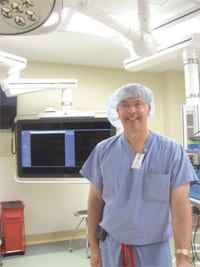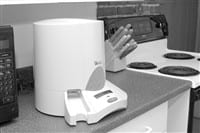Truly State of the Heart Baystate’s Davis Center is a Model of Efficiency
As he commenced a tour of the new Davis Heart & Vascular Center, and talked about its ability to save precious minutes in the delivery of care, Dr. Mark Hirko made early and repeated reference to a recent incident to get his points across.
In early June, a 17-year-old boy was rushed to Baystate Medical Center’s emergency room; he’d been involved in a horrific motorcycle accident, and along with a series of contusions and lacerations, his aorta — the largest artery that supplies blood to the rest of the body — was severely injured, said Hirko, chief of Vascular Surgery at Baystate. It was quickly determined that he needed surgery immediately, and time was not on his side.
He was moved to the recently opened Davis Center, just a few yards away, in what has been referred to for the past several years as the Hospital of the Future. Today, that patient is alive, said Hirko, adding that, if the same incident had occurred six months ago, the outcome might well have been different.
Simple geography has something to do with this, he continued, noting the Davis Center’s close proximity to the ER, but there’s more to it. Indeed, the Davis Center’s design and operational philosophy is centered on efficiency and collaboration, bringing vascular, cardiology, and radiology services together as a whole to promote collaboration and greater efficiency, save lives, and ultimately bring down the cost of care in the process.
There will be many more incidents like the motorcycle-crash victim, said Hirko, and individually and collectively, they will validate the time, study, collaboration, and, yes, sizable investment that went into creating the center. And it was a desire to be part of that process, and in effect introduce a new model for delivering care, that brought him to Baystate in the first place.
Indeed, Hirko had been involved in a similar initiative at a hospital in Youngstown, Ohio — one that was started and scrapped as the hospital fell into bankruptcy — and then another financial collapse at the Western Pennsylvania Hospital in Pittsburgh just a year later. He then commenced a search for both higher ground and a hospital exploring implementation of a multi-disciplinary system for vascular patients.
“I came here from Pittsburgh specifically to be a part of the planning of this facility,” said Hirko, whose sense of pride in what has been accomplished is palpable. “After all the starts and stops at other facilities, it’s nice to see this one has come to fruition.”
For this issue, HCN goes behind the scenes at the Davis Center to see how this vision became reality, and how the future, as in the Hospital of the Future, is now.
Room to Heal
As he led HCN into the heart and vascular critical care unit, he paused and said, “listen … nothing.”
Except for a low, morphed beeping sound, there is no clatter of trays or gurneys, none of the traditional hospital noise that interrupts a patient’s healing process and makes them feel like they are trying to sleep in someone’s office. “This is a high-risk, high-stress area, but it’s now patient-centered,” Hirko said. And this quiet area of healing is part of what makes this center so unique; he calls it the “on-stage” area.
The slightly curved, gently lit corridor that looks like the hallway of a posh hotel is exactly the setting that patients and their families, who are experiencing the highest stress of their lives, need to be in, said Hirko. The entire floor is ringed with patient rooms with a view; every bed faces a window. The center chamber, or ’off-stage area,’ is where the staff of nurses, doctors, and specialists congregate to review cases.
Hirko referenced the elaborate computer system that is connected to heart and vascular patients and, over a period of 72 hours, analyzes their urine, temperature, blood pressure, and myriad other vital signs, equipping providers with the data they need to render effective care.
“Everything is wired,” said Hirko. “This is extremely helpful for us, so that we aren’t constantly going back to the patient or the computer to look up things.” This new high-tech process of computer and human collaboration makes a high-risk experience far more stress-free for the patient, and helps to shave time-consuming and costly actions, ultimately bringing down the cost of providing care.
But the Davis Center is also staff-centered, Hirko continued. The hallways between the six operating rooms and their associated procedure rooms have skylights that let in natural light. “It helps with the environment; it helps with the employees so that they aren’t always in fluorescent lighting.” And while that may seem like such a simplistic effect, it’s that exact attention to detail, literally everywhere one looks, that makes this entire effort so amazing.
How all this came together is a textbook case of collaboration and inclusion, said Hirko, adding that, well before a single blueprint was drafted, input was sought from a host of constituencies, from doctors, nurses, EMTs, and specialists to patients, families, and even the maintenance crews.
They were asked to figuratively wave a magic wand and ask for anything and everything they could ever want in a heart and vascular center that would improve patient experience and their own productivity. And the requests were not just for the large, obvious changes, but smaller things that make a day go smoother. To prove that point, Hirko pointed to a typical double electrical wall socket that is about four feet up from the floor.
“The nurses specifically asked us, ’why do we have to bend down all the time to plug equipment in near the floor?’ And as you can see, the plans incorporated their wish,” said Hirko, adding that, while not every request could be met, most were, and he pointed to the large boom attached to the ceiling as another example.
“We couldn’t have literally everything that everyone from different specialty areas wanted, because we heard when other hospitals tried that, everybody collided,” he explained. “But in this case, the boom [to lift patients] worked out well, and the space is impressive.”
Taking a Pulse
Just as impressive are the six spacious advanced-procedure surgical suites, with a dedicated 20-room unit for outpatient cardiovascular procedures, 96 private inpatient rooms, and 32 cardiovascular critical-care rooms. What is really unique, Hirko said, is that the new ORs have everything necessary to perform multiple surgeries, such as bypasses and angioplasty procedures, at the same time, which in the past would have prompted moves to other parts of the hospital or a waiting game of the transportation of the machine to the patient or the patient to the machine.
Those can be critically important minutes in which life could be slipping away, he said, again referring to the case of the young man involved in the motorcycle accident.
The facilities at the Davis Center enable teams to take full advantage of new procedures that are revolutionizing vascular surgery, said Hirko, referencing, as just one example, a stent-graft procedure that involves the insertion of a lifesaving support mesh for patients suffering from aortic aneurysms (a weakening or ballooning of a blood vessel), which, if they lead to rupture, could prove fatal.
In the past, the high-risk operation would normally have been an ’open’ procedure, meaning actually opening the body up to reveal the weakened vessel, requiring a five-to six hour surgery and a stay of seven to nine days, starting in intensive care, followed by extensive rehab.
“Now, the procedure is done percutaneously,” he noted, meaning it uses a specialized needle catheter, which introduces the wire stent to the blood vessel to stop the leak and support its weakened wall. The surgery is conducted in two to three hours, and the patient is eating that afternoon and home the next day.
But beyond getting input into how to equip the new heart and vascular center, Hirko and those working with him needed something else — buy-in on what amounts to a new way of doing business in health care, one that streamlines operations and removes many of the silos and egos that get in the way of cost-effective care.
Getting such buy-in wasn’t easy, but necessary, he said, adding that the operating philosophy in place at the center removes much of what he called “overlap” in the delivery of services. And as he continued his tour, Hirko harkened back to a slogan put to use extensively during the center’s construction: “it’s more than a building.”
It was used to convey the point that the facility is about much more than bricks, mortar, and glass — it’s also about a combined model of care that one can see while walking the hallways and visiting the ORs.
“There is always that inherent competition, and we found that, if we could just trust each other and work together, we actually took better care of the patient — and, as a sideline, we got busier,” said Hirko, adding, for example, that the Davis Family Heart & Vascular Center will be one of the few centers in the country to merge radiology and vascular services, which is leading to more innovative care.
Model of Efficiency
Probably the most descriptive buzzword for the new Davis Center is ’efficiency,’ said Hirko, returning one more time to that patient from the motorcycle accident.
That incident, and many others, provide solid evidence that the new center is, indeed, much more than a building. It’s a place where design, technology, and a new, innovative system based on collaboration, not competition, have all come together.
As a result, the facility is not merely state of the art, but state of the heart.



Comments are closed.